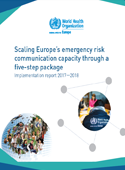Scaling Europe’s emergency risk communication capacity through a five-step package. Implementation report 2017–2018

Download
Emergency risk communication (ERC) is a public health intervention during outbreaks and health emergencies and a core capacity under the International Health Regulations (2005) (IHR) (1). Recent global health emergencies have proven that effective ERC shortens the time required for emergency control and ensures that affected communities receive the information they need as they need it. In February 2017, the WHO Regional Office for Europe created and launched a fivestep capacity-building package for ERC, the first of its kind.
The package builds on previous training in ERC in the Region since 2014. The approach consists of combining sustained technical guidance with the ingenuity of the host country, taking into account the country’s assets and ERC structure. The comprehensive package includes tools for multisectoral training, capacity mapping and development, testing and adoption of an ERC plan. It results in an ERC plan that is written by and for national communication responders and is adapted to the country’s emergency response system. The five-step package is designed to support development or strengthening of ERC response under the IHR in line with national approaches and commitment.
The package was pilot-tested in 13 countries and Kosovo* in 2017 and early 2018 and is to be extended to additional countries in 2018–2019. Countries and territories use the package according to their ERC capacity. The five steps guide workshop participants through the process of
- (i) bringing response partners together to establish understanding of effective ERC;
- (ii) identifying shared capacities;
- (iii) developing a plan for an interdependent response by national, regional and local partners;
- (iv) practising the plan in simulation exercises; and
- (v) establishing a plan for adoption of ERC.
This method measurably strengthened ERC capacity in the pilot countries and territories, which will serve as examples for further WHO regional ERC capacity-building. The areas identified in the pilot countries and territories in which ERC could be improved included coordination among response agencies, ensuring sustained human and financial resources and stronger engagement with communities. Opportunities for improving ERC are formulating or updating regulations and using existing systems and capacity better.
This report provides an overview of the project, its initial implementation, lessons learnt and future plans. The lessons were systematically used to improve the package for better country use for effective outcomes. They were also used to identify gaps and innovative, more advanced ERC approaches rather than less efficient, more expensive methods. Readers will recognize similar challenges in their countries and territories and find inspiration to address them with the package.
-----------------------------------
*All references to Kosovo should be understood in full compliance with United Nations Security Council Resolution 1244 (1999).



